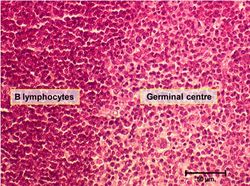Difference between revisions of "B cells"
Jump to navigation
Jump to search
| Line 4: | Line 4: | ||
<p>So named as they were initially found in the [[Bursa of Fabricius - Anatomy & Physiology|Bursa of Fabricius]], B cells produce antibodies (Ig’s) and are associated with humoral immunity. They represent 20-30% of circulating lymphocytes. | <p>So named as they were initially found in the [[Bursa of Fabricius - Anatomy & Physiology|Bursa of Fabricius]], B cells produce antibodies (Ig’s) and are associated with humoral immunity. They represent 20-30% of circulating lymphocytes. | ||
B cells have B cell receptors (BCRs), or antigen binding sites which combine as the antibody [[IgM]] when the B cell is immature, changing to [[IgD]] when the cell is mature. IgM has a large molecular mass and can bind up to 10 antigens simultaneously. B cells also express MHC II, CD9, CD,19, CD20 and CD24.</p> | B cells have B cell receptors (BCRs), or antigen binding sites which combine as the antibody [[IgM]] when the B cell is immature, changing to [[IgD]] when the cell is mature. IgM has a large molecular mass and can bind up to 10 antigens simultaneously. B cells also express MHC II, CD9, CD,19, CD20 and CD24.</p> | ||
| − | <p>Under antigenic stimulation | + | <p>Under antigenic stimulation [[B cell differentiation|B cells differentiate]] into [[B cell differentiation#Plasma cells|plasma cells]] and [[B cell differentiation#Memory cells|memory cells]].</p> |
B-cells also act as Antigen-Presenting Cells (APCs) by presenting digested fragments to [[T cells]] on [[Major Histocompatability Complexes#MHC II|MHC II]]. | B-cells also act as Antigen-Presenting Cells (APCs) by presenting digested fragments to [[T cells]] on [[Major Histocompatability Complexes#MHC II|MHC II]]. | ||
Revision as of 08:46, 27 September 2010
Also known as B lymphocytes
So named as they were initially found in the Bursa of Fabricius, B cells produce antibodies (Ig’s) and are associated with humoral immunity. They represent 20-30% of circulating lymphocytes. B cells have B cell receptors (BCRs), or antigen binding sites which combine as the antibody IgM when the B cell is immature, changing to IgD when the cell is mature. IgM has a large molecular mass and can bind up to 10 antigens simultaneously. B cells also express MHC II, CD9, CD,19, CD20 and CD24.
Under antigenic stimulation B cells differentiate into plasma cells and memory cells.
B-cells also act as Antigen-Presenting Cells (APCs) by presenting digested fragments to T cells on MHC II.
